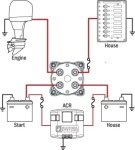Gilbertsons
New member
I'm making plans to install a couple of 100W flexible solar panels to my battery system and don't quite know the best way. I have inserted a diagram of my 2 battery system (1 Start, 1 House) with an ACR (Automatic Charging Relay). I guess this a typical set up with a single engine C-Dory like mine.
I understand that I need to connect the solar controller to the battery. I would guess that I would only need to connect only to the Start battery....(If I'm understanding how an ACR works). In my mind that would mean I would leave the battery switch in the "On" position so that the ACR senses the charging voltage coming up on the Start battery and then combines to charge the House battery automatically? I store the boat outside so this would ensure that my batteries are always topped off....(Is that wise?). But I also see that some solar controllers have the ability to connect to two batteries. Wouldn't this be unnecessary if you already have a ACR setup?
Most of the discussion I have found on the forum revolve around mounting the solar arrays, required wattage, interconnecting the panels, etc.
Any comments on how folks best connect to batteries and operate on a similar set up as mine?

I understand that I need to connect the solar controller to the battery. I would guess that I would only need to connect only to the Start battery....(If I'm understanding how an ACR works). In my mind that would mean I would leave the battery switch in the "On" position so that the ACR senses the charging voltage coming up on the Start battery and then combines to charge the House battery automatically? I store the boat outside so this would ensure that my batteries are always topped off....(Is that wise?). But I also see that some solar controllers have the ability to connect to two batteries. Wouldn't this be unnecessary if you already have a ACR setup?
Most of the discussion I have found on the forum revolve around mounting the solar arrays, required wattage, interconnecting the panels, etc.
Any comments on how folks best connect to batteries and operate on a similar set up as mine?

